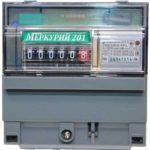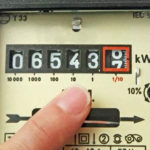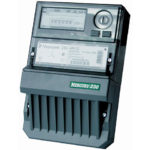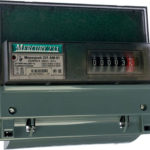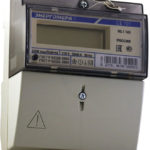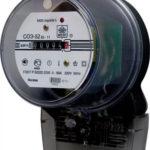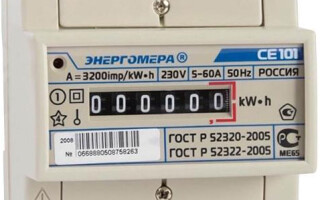Electric meter Energomera SE-101 is common in single-phase AC networks for single-tariff metering of consumed electricity.
The meter refers to modern devices, the use of which is recommended by energy supplying organizations. Certified by State Register of Measuring Instruments
Subject of
Description of the meter
The single-phase electricity meter is designed for switching into ac network with voltage not higher than 240 V to measure the active load. The nominal load current is 5A and the maximum current is 60A for the model 145 or 10 and 100A for the model 148.
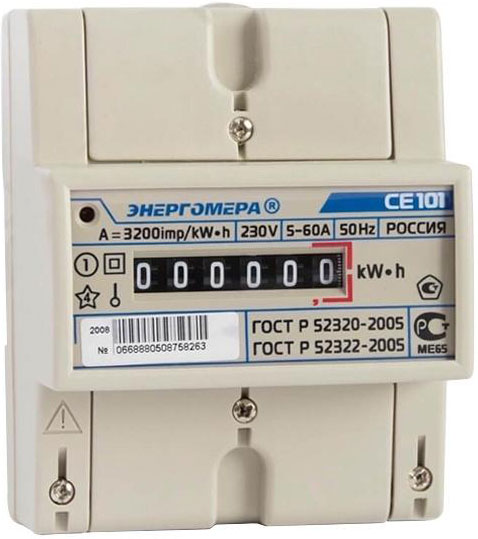
The meter is available in 3 mounting options, which are indicated by an additional marking in the designation of devices:
- S6 or S10 - mounting to the panel with 3 screws;
- R5 - fixing on DIN-rail;
- R5.1 - universal mounting.
The current measurement is performed by means of a shunt, which excludes the possibility of electromagnetic interference. In addition, the measuring system and the counting mechanism are equipped with an electromagnetic shield and a backstop, making it impossible to steal electrical energy or distort readings.
The casing of the Energomera CE 101 meter is made of shockproof and non-flammable plastic.
A special feature is a low value of starting current - 10mA, which provides high sensitivity (counting power consumption begins with the values of 2W).
The service life of the electricity meter is not less than 30 years.
Light indicators
On the front panel of electric meters there are 1 or 2 LEDs. One of the LED's, indicated as "3200 imp/kW-h" or "1600 imp/kW-h" has 2 functions:
- continuous glow - connected to the mains and no power consumption;
- flickering - proportional to the load.
This indicator is available in all models of electric meters.
The CE101 S6 and S10 models feature a second "Robr" indicator that illuminates when reverse power is present.
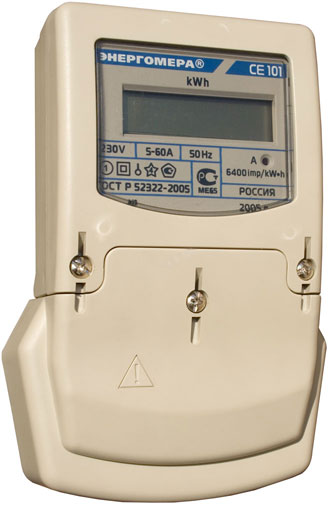
The mains and load indicator lights with a reduced brightness when the power consumption is below the threshold. When the load increases, the LED begins to turn on brightly for 30-90 ms with a frequency proportional to the value of the load.
By counting the number of counter pulses for a selected period of time, you can determine the amount of power consumed. This function of the CE 101 is convenient for remote control and failure of the indicator.
Features of the display panel
The indicator panel is available in several versions. Each of the modifications of the indicator is reflected in the marking of the device:
- M6 - six-segmental;
- M7 - seven-segmental;
- no "M" symbol - liquid crystal.
Devices with an electronic liquid crystal display are more reliable because they do not have moving elements, but are characterized by a narrower range of permissible operating temperature. This is due to the fact that LCDs lose functionality at high negative temperature values.
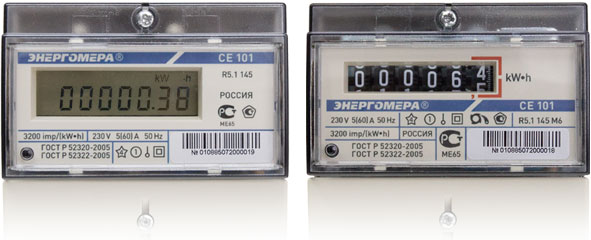 The mechanical display devices of CE 101 devices have an additional segment showing tenths of kilowatts. This section is circled on the indicator with a red border and is not taken into account when taking readings.
The mechanical display devices of CE 101 devices have an additional segment showing tenths of kilowatts. This section is circled on the indicator with a red border and is not taken into account when taking readings.
Connection of the meter
Before you connect the meter, you should read its documentation and check the device numbers on the case and in the device form. If you have purchased a meter in a store, it is always supplied with a meter data sheet and an operating manual. The instructions contain the technical parameters of the meter and the connection diagram.
Devices manufactured at different times may have some differences in wiring, so it is necessary to use the diagram given on the inside surface of the terminal block cover.
The wiring diagram is universal and involves the connection of 4 conductors:
- 1 - phase input (mains);
- 3 - phase outlet (load);
- 4 - zero input (mains);
- 5(6) - zero output (load).
Work on the connection of the CE 101 meter can only be carried out when there is no mains voltage. The procedure is as follows:
- disconnect power at the input cable;
- Install the meter, mains input and load circuit breakers on the distribution board;
- clean up the ends of the lead-in cable;
- switch on the power and using a screwdriver identify and mark the phase wire;
- Switch off power supply again;
- clamp the lead-in wires to the terminals of the terminal block in accordance with the diagram
- connect the load wires;
- apply power;
- check the presence of voltage at the meter output;
- connect the load and make sure that the meter reading increases in proportion to the load.
Each terminal has 2 screws. The length of the insulation to be stripped should be such that the bare conductor does not extend beyond the terminal and the insulation does not get under the screws.
Tighten the upper screw first, and then, after making sure the wire is firmly clamped, tighten the lower screw.
When using stranded wire it is necessary to crimp the ends with a special lug or to tin and solder the wires.
The meter Energomera CE 101 will not work in case of intentional or accidental wrong connection.
Modern electrical wiring is characterized by the presence of 3 conductors, one of which is used to connect the ground. This wire is not used in the wiring diagram of the electric meter. The grounding wire can be identified by the yellow-green color of the insulation.
Meter readings and verification
To take readings for accounting, only the digits not circled by a red border are taken, and for devices with liquid crystal displays - only the digits before the decimal point.
Meters are verified by specialized organizations. The verification interval is 16 years. Extraordinary verification is performed after repairs. Devices that come on sale already have verification, but its period should not be more than 2 years. Otherwise, recalibration is required.
To protect against tampering, CE electric meters have a special holographic sticker. The screw that fastens the parts of the housing is sealed. The date of verification of the device is indicated on the seal.
Related articles:
